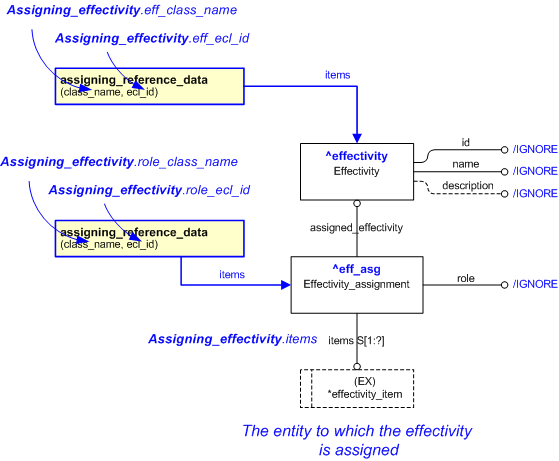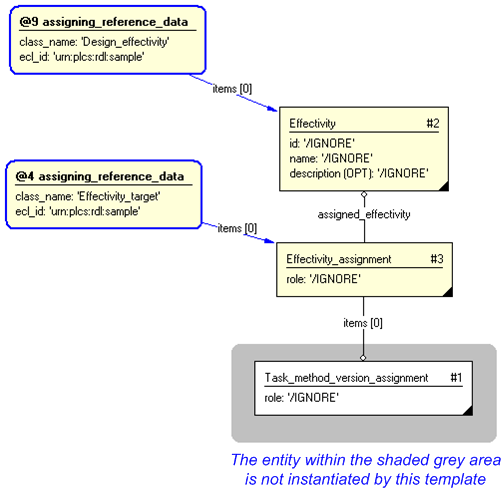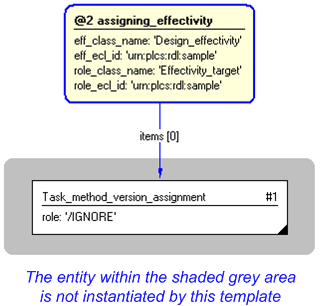Template:— assigning_effectivity (asg_eff)
Capability:assigning_effectivity |
Date: 2009/04/03 08:35:25
Revision: 1.10
|
This section specifies the template assigning_effectivity.
NOTE
The template has been defined in the context of the capability
assigning_effectivity
which provides an overall description of the
relevant parts of the ISO 10303-239 information model and a description
of related templates.
NOTE
An explanation of a template and the associated instantiation path is
provided in the
Template overview
section.
This template describes how to represent the assignment of an
Effectivity.
The EXPRESS-G diagram in
Figure
1
shows the templates and EXPRESS entities that are required
to represent the template
"assigning_effectivity".
The text highlighted in blue shows the template parameters.
Figure 1 — An EXPRESS-G representation of the Information model for assigning_effectivity
The graphic for the template to be used in other EXPRESS-G diagrams
is shown in Figure
2
below.
Figure 2 — The graphical representation of the assigning_effectivity template
The following input parameters are defined for this template:
The name of the class being used to classify the
effectivity
(
Effectivity)
This provides the role for the effectivity.
The following classes and their sub-classes can be used:
The identifier of the
External_class_library
storing the definition of the class referenced by the parameter @eff_class_name.
The name of the class being used to classify the
effectivity assignment
(
Effectivity_assignment)
This provides the role for the assignment.
The following classes and their sub-classes can be used:
The identifier of the
External_class_library
storing the definition of the class referenced by the parameter @role_class_name.
The items to which the effectivity is assigned.
The following reference parameters are defined for this template:
Allow the
Effectivity_assignment
entity instantiated in this path to be referenced when this template is used.
%^target = $assigning_effectivity.eff_asg%
Allow the
Effectivity
entity instantiated in this path to be referenced when this template is used.
Note: The
Effectivity
entity can be referenced in a template path by:
%^target = $assigning_effectivity.effectivity%
where
target
is the parameter to which the
Effectivity
is bound.
The instantiation path shown below specifies the entities that are to be
instantiated by the template.
A description of templates and the syntax for the instantiation path is
provided in the
Templates Help/Information section.
-- Instantiate the Effectivity entity Effectivity-- Set the Effectivity attributes id, name and description to be ignored Effectivity.id = '/IGNORE'
Effectivity.name = '/IGNORE'
Effectivity.description = '/IGNORE'
-- Bind the Effectivity entity to the parameter ^effectivity. -- The parameter is a reference parameter so the Effectivity -- entity can be referred to when this template is used. %^effectivity =
Effectivity%
-- Assign reference data to Effectivity /
assigning_reference_data(
items=^effectivity,
class_name=@eff_class_name,
ecl_id=@eff_ecl_id)/
-- Instantiate Effectivity_assignment entity Effectivity_assignment-- Set the Effectivity_assignment attribute role to be ignored Effectivity_assignment.role = '/IGNORE'
-- Bind the Effectivity_assignment to the parameter ^eff_asg. -- The parameter is a reference parameter so the Effectivity_assignment -- entity can be referred to when this template is used. %^eff_asg =
Effectivity_assignment%
-- Assign reference data to Effectivity_assignment /
assigning_reference_data(
items=^eff_asg,
class_name=@role_class_name,
ecl_id=@role_ecl_id)/
-- Set the Effectivity_assignment.assigned_effectivity attribute to the Effectivity entity -- instantiated at the beginning of this path Effectivity_assignment.assigned_effectivity ->
Effectivity-- Assign the Effectivity_assignment -- to the instances passed into the template through the @items -- input parameter Effectivity_assignment.items ->
@items
The following entities are instantiated with attributes as specified:
The instance diagram in Figure
3
shows an example of the EXPRESS entities and templates that are instantiated by the template:
/assigning_effectivity(items='#1', eff_class_name='Design_effectivity', eff_ecl_id='urn:plcs:rdl:sample', role_class_name='Effectivity_target', role_ecl_id='urn:plcs:rdl:sample')/
(an illustration of the consolidated assigning_effectivity template is shown in
Figure
4 below.)
Figure 3 — Entities instantiated by assigning_effectivity template
The instance model in STEP ASCII exchange file format (ISO 10303 Part
21 syntax) is:
#1 = TASK_METHOD_VERSION_ASSIGNMENT($,(),'/IGNORE');
#2 = EFFECTIVITY('/IGNORE','/IGNORE','/IGNORE');
#3 = EFFECTIVITY_ASSIGNMENT(#2,'/IGNORE',(#1));
#5 = CLASSIFICATION_ASSIGNMENT(#7,(#3),'/IGNORE');
#7 = EXTERNAL_CLASS('/NULL','Effectivity_target','/IGNORE',#8);
#8 = EXTERNAL_CLASS_LIBRARY('urn:plcs:rdl:sample',$);
#10 = CLASSIFICATION_ASSIGNMENT(#12,(#2),'/IGNORE');
#12 = EXTERNAL_CLASS('/NULL','Design_effectivity','/IGNORE',#8);
The instance diagram in
Figure
4
shows the graphic symbol for the template that is to be
used in other instance diagrams. The example template is:
/assigning_effectivity(items='#1', eff_class_name='Design_effectivity', eff_ecl_id='urn:plcs:rdl:sample', role_class_name='Effectivity_target', role_ecl_id='urn:plcs:rdl:sample')/
Figure 4 — Instantiation of assigning_effectivity template
The following section details how the
assigning_effectivity
template can be optionally characterized by assigning
other constructs to it. These are characterizations commonly
applied to the template. The ISO 10303-239 EXPRESS model may enable
other assignments to the entities instantiated by the template.
The following characterizations may apply:
Characterization Assigning descriptions
NOTE this characterization is optional.
Characterization Assigning identifications
NOTE this characterization is optional.




